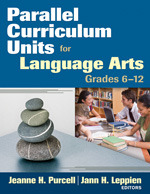Parallel Curriculum Units for Language Arts, Grades 6-12
- Jeanne H. Purcell - Connecticut State Department of Education
- Jann H. Leppien - University of Great Falls
"The Parallel Curriculum Model (PCM) holds the power to help students and teachers 'see the whole' of what they are learning. We invite practitioners to read more about this model and join us on a professional journey that we believe will yield that joy and wisdom that comes from seeing the whole. To address the varying needs of teachers across the K–12 grade span—as well as different content areas—we decided to create a series of curriculum units, based on PCM, that could be used by practitioners. It is our hope that the lessons not only underscore important and discipline-specific content, but also illuminate the four parallels in unique and enduring ways."
—From the Introduction
Design exemplary language arts lessons based on the Parallel Curriculum Model!
Want to create rigorous learning opportunities for students in language arts based on a deeper understanding of pedagogy and curriculum design? As demonstrated in the best-selling book The Parallel Curriculum, the Parallel Curriculum Model (PCM) allows teachers to determine student performance levels and design intellectual challenges that help students develop expertise in specific subject areas.
Parallel Curriculum Units for Language Arts, Grades 6–12 provides sample language arts units written by practicing teachers to demonstrate what high-quality curriculum looks like within a PCM framework. Covering a variety of topics—including narrative voice, literary criticism, and writing original pieces—these field-tested units each contain:
- Teacher rationales explaining the unit design
- Connections to concepts, skills, and national or state standards
- Step-by-step directions for delivering the lessons and unit
- Modification strategies, assessments, and reproducibles
Use these examples to design your own units and deepen your understanding of how the PCM framework helps tailor curriculum to the abilities, interests, and learning preferences of each learner.
When I state adopted, here, obviously, by nature of the text, it is not for student distribution. Rather, I reviewed it gain a better perspective on ELA 6-12 practices - practices the book advertises as beneficial. Gaining the insight better enables us to place into context similar, extended curricula across our core composition courses and professional service/development courses. Therefore, by virtue of adoption, I myself will rely on it. However, I will also encourage the appropriate sources - colleagues, administrators, etc. - when appropriate to review the text. When - and my apologies, but I can't predict a time frame at the moment - I see a group or opening for distribution across faculty and others for immediate and direct purposes, I will have the appropriate department at the university purchase the required number of texts at that time.



